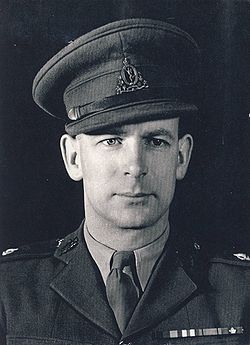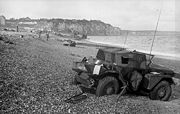Rolfe, Gordon MacDonald
| Gordon MacDonald Rolfe | |
|---|---|
| 18 October 1910 – 1991 | |
 | |
| Nickname | Shorty |
| Place of birth | Homer, Ontario |
| Place of burial | Pinecrest Cemetery, Ottawa |
| Allegiance | Canada |
| Service/branch | Canadian Army |
| Rank | Colonel |
| Awards | DSO, MBE, CD |
Early Life
Gordon was born at Homer Ontario on 18 October 1910 to Thomas Rolfe and Dorothy Godfrey. He is listed as having received three years private tutoring and two years of education at Central Technical School.[1]
Service
In 1927 at the age of 17, Gordon joined the Royal Canadian Corps of Signals as a Boy Soldier and was trained at the Royal Canadian Corps of Signals Depot in Bordon Ontario. Having achieved the rank of Lance-Corporal, he left the Canadian Army 30 April 1930 only to rejoin again less than five months later on 23 September 1930. He was posted to Radio Beacon Station, Forrest Manitoba until March 1932 after which he served with the Northwest Territories and Yukon Radio System. He was promoted Corporal effective 1 October 1935 and was posted to Fort Resolution, Northwest Territories until 1937. Having been promoted Sergeant effective 1 August 1937, he was serving at the Signal Training Centre in Kingston Ontario when war was declared 1 September 1939.
Sgt Rolfe was posted to 1st Divisional Signals and proceeded to England with the unit in December 1939. A clearly capable soldier, he was commissioned as a Lieutenant 8 September 1940. With the advent of armoured operations, Rolfe was sent to learn from the British prior to returning to Canada in January 1941. He was made Acting Officer Commanding of a newly forming unit, 1st Army Tank Brigade Signals, and in April 1941 was promoted Captain effective 20 February 1941. After training at Camp Borden Ontario, the unit proceeded overseas departing Halifax on 21 June and arriving in Great Britain on 30 June 1941. Training continued in England through 1942 and in May 1942 he was promoted Major with effect from 11 April.
When preparations for the Dieppe Raid were undertaken, first known as OPERATION RUTTER and later resurrected as OPERATION JUBILEE, the Commanding Officer of The 14th Canadian Army Tank Regiment (The Calgary Regiment (Tank)) requested that Major Rolfe be attached to the unit. LtCol Andrews, who had been the Brigade Major and was a close friend of Rolfe's, requested that the Brigade Commander attach Rolfe to The Calgary Regiment to work on the unit's Signal Plan as their Signal Officer was newly arrived and inexperienced. As Rolfe later wrote, "once in the picture there was no way out of permanently becoming part of the operation"[1].
For the raid, Rolfe, in charge of 13 members of 1st Army Tank Brigade Signals and three Daimler Scout Cars, was tasked to report to HQ 6th Brigade, commanded by Brigadier Southam, at St Remy Church to coordinate the withdrawal of the infantry and tanks. Each scout car had an Armoured Corps driver and an RCCS Signal operator. Rolfe's scout car was named HUNTER while the other two were HOUND and HARE. Towed off Tank Landing Craft 7 (TLC-7) by a Churchill tank, HUNTER was partly crushed and driven into the soft shale beach when the tank reversed. The scout car, although looking like a derelict to the enemy, still had functional radios and served as a critical link in the operation. Joined by L/Cpl Wills from HOUND and Brigadier Southam whose own communications were destroyed, Rolfe was able to communicate with the infantry and armoured forces ashore and the ships out to sea by continually changing frequencies. Thus HUNTER became a critical link between the flotilla and the beach for the duration of the operation. It was by this means that the withdrawal of the forces on the beach was arranged. Having stayed behind to arrange the withdrawal, Rolfe burned his signal books and codes[2] and destroyed his equipment with a grenade before being forced to surrender to the German forces[3]. He was awarded the Distinguished Service Order for his gallant and distinguished service at Dieppe[4].Now a Prisoner of War (POW), Rolfe was taken along with the other Officers to Oflag VIIB at Eichstatt in Bavaria.[5]Throughout his time as a POW, Rolfe was continually scheming and trying to escape. It was on the train ride from France to Oflag VIIB that he made his first attempt by jumping off the train while it was in a tunnel. Unfortunately, both ends of the tunnel were guarded and he was apprehended and continued on to the POW camp. Once in Oflag VIIB, the scheming didn't stop. On the night of 3/4 June 1943, 65 British Officers including Rolfe escaped via a tunnel. Upon recapture, they were punished for 14 days in "the dungeon" of the castle before being held in what served as the German canteen until they could be transferred to another camp. One of 12 held longer on a charge of wearing civilian clothing, they learned that they would be moved the next day and so, on the evening of the 20 June 1943, they put another escape plan into action. During the day, they removed the bars of their cell and prepared the dummies that would take their place in the beds that night. When one of their companions "needed" to use the lavatory and the guard went with him, Rolfe and two others used a rope that had been smuggled in to the prison to lower themselves to the ground. There were issues with the rope and Rolfe ended up dropping about 20 feet to the ground wrenching his spine and nearly being knocked out cold. Successfully getting away from the castle and circling the village, they were apprehended while walking along a train track by an S.S. soldier who happened to be in a booth beside the tracks with a girl friend. Rolfe was moved to Oflag IVC, the "Sonderlager" or Special Camp which was a high security camp for officers. The majority of those held had there had escaped from other camps several times. Although he served on the escaping organization for the camp, he was not able to escape again.[6] For his leadership in escape achievements, he was made a Member of the Order of the British Empire[7].
Freed by American forces on 15 April 1945, Rolfe was back in England on the 18th. By 9 May he was back with the Canadian Army and visiting 2 Corps Headquarters Signals.[8] He served with 5 Armoured Divisional Signals from May until Sep 1945 after which he was repatriated to Canada. Upon his return, he volunteered for the Interim Force and was extra regimentally employed with the Director of Signals in Ottawa. He joined the Active Force in September 1946 at the rank of Major. Appointed GSO I with D Sigs, he was made an Acting Lieutenant-Colonel. After completion of the Canadian Army Staff Course in 1948, he served as GSO I and later as Deputy Director with the Directorate of Military Training at Army Headquarters. After attending the United States Armed Forces Staff College, he served as Assistant-Adjutant and Quartermaster-General at Headquarters Prairie Command from 1952 until 1954. In 1955 he went overseas to serve with the International Commissions for Supervision and Control to Indo-China as Commanding Officer and Deputy Military Advisor of the Military Component, Canadian Delegation Laos. Upon his return in 1956, he was appointed Chief Signal Officer at Western Command Headquarters where he served until 1958. Promoted Colonel, he was appointed Deputy Director and later Director of the Department of Weapon Development at Army Headquarters. In May 1962, he was appointed Director of the Directorate of Equipment Policy. He retired on 7 February 1963.[9]
Distinguished Service Order Citation
The citation for his Distinguished Service Order, originally submitted as a Military Cross, read:
- Responsibility for maintenance of communications between H.Q. 6 Cdn Inf Bde and the Calgarys was charged to Major Gordon Rolfe, during the Dieppe operation 19 Aug 42. Landing with the initial attacking wave, in spite of intense enemy opposition he succeeded in leading his party to the appointed rendezvous. In a most exposed position he continued to maintain contact between ship and shore, keeping tank commanders informed as to the location of targets. When the withdrawal was ordered he was able to co-ordinate the defensive action of the tanks to cover the infantry evacuation. As a result of his direction the re-embarkation of the infantry was made possible. his distinguished service in this action was indicative of a high order of military skill and cool direction.
Personal Life
He married Isabel 29 December 1937. He died in 1991 at the age of 81 and is buried in Pinecrest Cemetery, Ottawa.
Related Pages
- Fort Resolution Official Reports 1936-37
- Fort Resolution Unofficial Reports 1935-37
- Gordon Rolfe's NWT and Y Photo Album 1933-37
- Operation Jubilee and Canadian Signals
Related Items
References and Notes
- ↑ 1.0 1.1 Research folder, Military Communications and Electronics Museum
- ↑ Rolfe noticed that Brigadier Southam still had his copy of the military plan as the surrender started and repeatedly asked to add it to the fire. Southam refused feeling he still needed at and later unsuccessfully tried to bury it on the beach. Dieppe, The Shame and the Glory; Terrance Robertson, Little, Brown and Company. Page 379
- ↑ Dieppe, The Shame and the Glory; Terrance Robertson, Little, Brown and Company. Page 379
- ↑ The London Gazette, Supplement 37499. 12 March, 1946. Page 1367.
- ↑ History of the Royal Canadian Corps of Signals 1903-1961, page 123.
- ↑ Detour, the story of Oflag IVC. Edited by Lieut J.E.R. Wood, MC. The Falcon Press, 1946. Pages 69-70.
- ↑ The London Gazette, Supplement 37664. 23 July, 1946. Page 3825.
- ↑ War Diary, 2 Corps Signals. 9 May 1945.
- ↑ Semaphore to Satellite, Appendix 34.
| ||||||||
.



















